
Nokia Corporation is a Finnish multinational telecommunications, information technology, and consumer electronics corporation, originally established as a pulp mill in 1865. Nokia's main headquarters are in Espoo, Finland, in the Helsinki metropolitan area, but the company's actual roots are in the Tampere region of Pirkanmaa. In 2020, Nokia employed approximately 92,000 people across over 100 countries, did business in more than 130 countries, and reported annual revenues of around €23 billion. Nokia is a public limited company listed on the Nasdaq Helsinki and New York Stock Exchange. It was the world's 415th-largest company measured by 2016 revenues, according to the Fortune Global 500, having peaked at 85th place in 2009. It is a component of the Euro Stoxx 50 stock market index.
The Nokia 3310 is a discontinued GSM mobile phone announced on 1 September 2000, and released in the fourth quarter of the year, replacing the popular Nokia 3210. It sold very well, being one of the most successful phones, with 126 million units sold worldwide, and being one of Nokia's most iconic devices. The phone is still widely acclaimed and has gained a cult status due to its reputation for durability.

Nokia 8210 is a mobile phone by Nokia, announced on 8 October 1999 in Paris. At the time, it was the smallest, lightest Nokia mobile phone on the market. A primary selling point of its design was its removable cover that allowed for easy customization. Six differently coloured Xpress-on covers are available, as well as many third-party ones.

The Nokia 6233 phone made by Nokia is the successor to the Nokia 6230i. It is a 3G/GSM/WCDMA mobile phone that runs the Series 40 3rd Edition, Feature Pack 1 UI on the Nokia operating system.
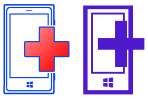
Microsoft Software Updater is a Windows and OS X based application launched in 2006, that enables customers to update and recover their mobile device firmware of a S40 or S60 or Lumia device from any Internet enabled access point. To avoid data loss users are prompted with on-screen advice on how to safely update their device.

The Nokia N95 is a mobile phone produced by Nokia as part of their Nseries line of portable devices. Announced in September 2006, it was released to the market in March 2007. The N95 ran S60 3rd Edition, on Symbian OS v9.2. It has a two-way sliding mechanism, which can be used to access either media playback buttons or a numeric keypad. It was first released in silver and later on in black, with limited edition quantities in gold and purple. The launch price of the N95 was around €550.

Nokia 8110 is a mobile phone released in 1996. It was announced on 9 September 1996, as the first of Nokia's high-end 8000 series of phones. Its distinctive styling was the first example of a 'slider' form factor. A sliding cover protected the keypad when being carried in the pocket and extended downwards in use, bringing the microphone closer to the mouth. The action of opening the cover also answered an incoming call. The prominent curvature of the case, particularly when open, earned it the nickname "banana phone". It was also the first Nokia phone with monochrome graphic LCD.

The Nokia 1110 and Nokia 1110i/1112 are low-end GSM mobile phones sold by Nokia. The 1110 was released in 2005; the 1110i/1112 was released in 2006. Both are aimed at first-time mobile phone users. In Nokia's view, the 1110i has the advantage of ease-of-use, reliability and a low price. These phones are very similar to the Nokia 1100. Between January and May 2007, the 1110 was sold by Nokia as their basic low-end monochrome model, before being superseded by the Nokia 1200. One of its key markets is that of developing countries.
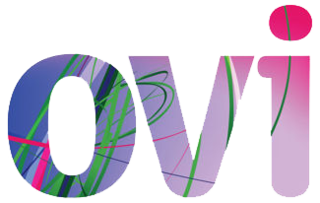
Ovi was the brand for Nokia's Internet services from 2007 to 2012. It was designed to be an umbrella brand as Nokia attempted to expand into software and Internet services instead of just mobile hardware. Ovi focused on five key service areas offered by Nokia: Games, Maps, Media, Messaging and Music.
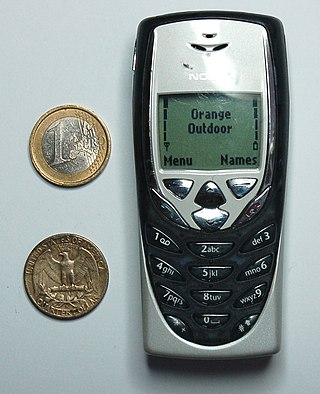
The Nokia 8310 is a mobile phone manufactured by Nokia between 2001 and 2002. Belonging to the 8000 series, the handset was a member of Nokia's flagship premium 'candybar' variety, and retailed for a price in excess of £400 on launch after its announcement at CEBIT in March 2001. Incorporating Nokia's trademark menu system and GUI with a white backlight, the device was easy to operate, yet contained advanced premium features not normally found on handsets of the time, such as infrared, a fully functional calendar, and was the first Nokia phone to support GPRS and an FM Radio. It was also the lightest Nokia phone to feature a polyphonic startup sound, despite not having polyphonic ringtones built into the phone, possibly due to the muffled sound.
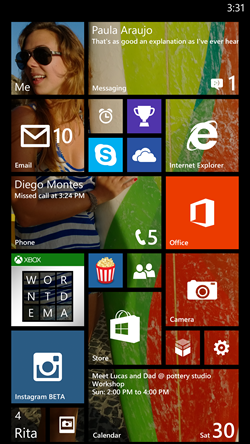
Windows Phone (WP) is a discontinued mobile operating system developed by Microsoft Mobile for smartphones as the replacement successor to Windows Mobile and Zune. Windows Phone featured a new user interface derived from the Metro design language. Unlike Windows Mobile, it was primarily aimed at the consumer market rather than the enterprise market.
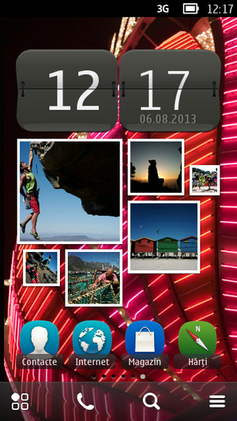
Symbian was a mobile operating system (OS) and computing platform designed for smartphones. It was originally developed as a proprietary software OS for personal digital assistants in 1998 by the Symbian Ltd. consortium. Symbian OS is a descendant of Psion's EPOC, and was released exclusively on ARM processors, although an unreleased x86 port existed. Symbian was used by many major mobile phone brands, like Samsung, Motorola, Sony Ericsson, and above all by Nokia. It was also prevalent in Japan by brands including Fujitsu, Sharp and Mitsubishi. As a pioneer that established the smartphone industry, it was the most popular smartphone OS on a worldwide average until the end of 2010, at a time when smartphones were in limited use, when it was overtaken by iOS and Android. It was notably less popular in North America.
Nokia's strategic nomenclature can be traced back in 2005 when the Nseries line was launched, offering devices with flagship specifications and premium hardware at various price points. These devices were considered the "bread and butter" of the company and were often positioned to showcase their latest technologies. Thanks to the newfound consumer and enterprise interest in smartphones at the time, the company introduced four additional collections to diversify their product portfolio and meet demands in most market segments. These new phone series were named Eseries, targeting small business and enterprise customers; Xseries, providing consumer-grade multimedia-focused devices; Cseries, which Nokia used to target both the low-end and mid-range market segments; and Tseries, for devices exclusive to the Chinese market.

Microsoft Lumia is a discontinued line of mobile devices that was originally designed and marketed by Nokia and later by Microsoft Mobile. Introduced in November 2011, the line was the result of a long-term partnership between Nokia and Microsoft—as such, Lumia smartphones run on Microsoft software, the Windows Phone operating system; and later the newer Windows 10 Mobile. The Lumia name is derived from the partitive plural form of the Finnish word lumi, meaning "snow".
Microsoft mobile services are a set of proprietary mobile services created specifically for mobile devices; they are typically offered through mobile applications and mobile browser for Windows Phone platforms, BREW, and Java. Microsoft's mobile services are typically connected with a Microsoft account and often come preinstalled on Microsoft's own mobile operating systems while they are offered via various means for other platforms. Microsoft started to develop for mobile computing platforms with the launch of Windows CE in 1996 and later added Microsoft's Pocket Office suite to their Handheld PC line of PDAs in April 2000. From December 2014 to June 2015, Microsoft made a number of corporate acquisitions, buying several of the top applications listed in Google Play and the App Store including Acompli, Sunrise Calendar, Datazen, Wunderlist, Echo Notification Lockscreen, and MileIQ.

Microsoft Mobile Oy was a Finland subsidiary of Microsoft Devices involved in the development and manufacturing of mobile phones. Based in Keilaniemi, Espoo, it was established in 2014 following the acquisition of Nokia's Devices and Services division by Microsoft in a deal valued at €5.4 billion, which was completed in April 2014. Nokia's then-CEO, Stephen Elop, joined Microsoft as president of its Devices division following the acquisition, and the acquisition was part of Steve Ballmer's strategy to turn Microsoft into a "devices and services" company. Under a 10-year licensing agreement, Microsoft Mobile held rights to sell feature phones running the S30/S30+ platform under the Nokia brand.

The Nokia 2010 is a mobile phone that was announced by Finnish phone manufacturer Nokia in January 1994.
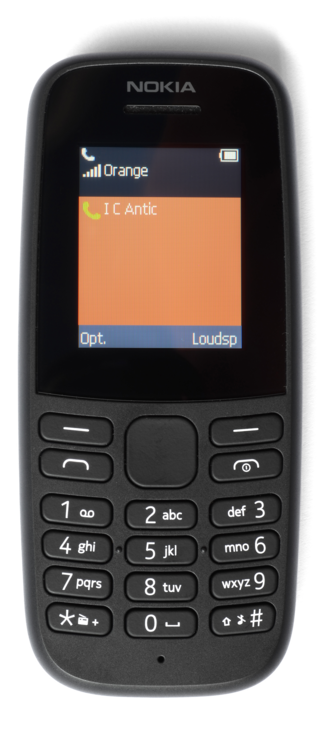
Series 30+ is a software platform and application user interface used for Nokia-branded, then HMD-branded mobile devices since 2024. The platform was introduced by Nokia in September 2013, first appearing on the Nokia 108, and has been the main Nokia feature phone operating system after the end of the Series 30 and Series 40 platforms in 2014. Despite the similar name and user interface, the S30+ is technically completely different and unrelated to the S30.

HMD Global is a Finnish independent mobile phone manufacturer. The company is owned by the Luxembourgish holding company Smart Connect GL. The company is made up of the mobile phone business that the Nokia Corporation sold to Microsoft in 2014, then bought back in 2016. HMD began marketing Nokia-branded smartphones and feature phones on 1 December 2016. The company has exclusive rights to the Nokia brand for mobile phones through a licensing agreement. The HMD brand was initially only used for corporate purposes and does not appear in advertising, whereas the name "Nokia Mobile" is used on social media. In January 2024, HMD rebranded to 'Human Mobile Devices' and will use its branding on future devices alongside that of Nokia.
The Nokia 1006 is a phone with a basic design for CDMA Technology. It was announced on 8 January 2009 and was released in the same month, marketing in Mexico by Iusacell and mostly in the USA by MetroPCS. This bar-style mobile has Bluetooth features, voice dialing and also has a GPS of A-GPS type.















